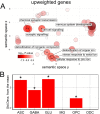Regional brain iron and gene expression provide insights into neurodegeneration in Parkinson's disease
- PMID: 33704443
- PMCID: PMC8320305
- DOI: 10.1093/brain/awab084
Regional brain iron and gene expression provide insights into neurodegeneration in Parkinson's disease
Abstract
The mechanisms responsible for the selective vulnerability of specific neuronal populations in Parkinson's disease are poorly understood. Oxidative stress secondary to brain iron accumulation is one postulated mechanism. We measured iron deposition in 180 cortical regions of 96 patients with Parkinson's disease and 35 control subjects using quantitative susceptibility mapping. We estimated the expression of 15 745 genes in the same regions using transcriptomic data from the Allen Human Brain Atlas. Using partial least squares regression, we then identified the profile of gene transcription in the healthy brain that underlies increased cortical iron in patients with Parkinson's disease relative to controls. Applying gene ontological tools, we investigated the biological processes and cell types associated with this transcriptomic profile and identified the sets of genes with spatial expression profiles in control brains that correlated significantly with the spatial pattern of cortical iron deposition in Parkinson's disease. Gene ontological analyses revealed that these genes were enriched for biological processes relating to heavy metal detoxification, synaptic function and nervous system development and were predominantly expressed in astrocytes and glutamatergic neurons. Furthermore, we demonstrated that the genes differentially expressed in Parkinson's disease are associated with the pattern of cortical expression identified in this study. Our findings provide mechanistic insights into regional selective vulnerabilities in Parkinson's disease, particularly the processes involving iron accumulation.
Keywords: Parkinson’s disease; genetics; iron; quantitative susceptibility mapping; transcriptomics.
© The Author(s) (2021). Published by Oxford University Press on behalf of the Guarantors of Brain.
Figures




Similar articles
-
Regional brain iron correlates with transcriptional and cellular signatures in Alzheimer's disease.Alzheimers Dement. 2025 Jan;21(1):e14459. doi: 10.1002/alz.14459. Alzheimers Dement. 2025. PMID: 39876820 Free PMC article.
-
The whole-brain pattern of magnetic susceptibility perturbations in Parkinson's disease.Brain. 2017 Jan;140(1):118-131. doi: 10.1093/brain/aww278. Epub 2016 Nov 11. Brain. 2017. PMID: 27836833
-
Transcriptomic profiles in Parkinson's disease.Exp Biol Med (Maywood). 2021 Mar;246(5):584-595. doi: 10.1177/1535370220967325. Epub 2020 Nov 4. Exp Biol Med (Maywood). 2021. PMID: 33148011 Free PMC article.
-
Neurodegeneration in Parkinson's disease: interactions of oxidative stress, tryptophan catabolites and depression with mitochondria and sirtuins.Mol Neurobiol. 2014 Apr;49(2):771-83. doi: 10.1007/s12035-013-8554-z. Epub 2013 Oct 2. Mol Neurobiol. 2014. PMID: 24085563 Review.
-
What have we learnt from CDNA microarray gene expression studies about the role of iron in MPTP induced neurodegeneration and Parkinson's disease?J Neural Transm Suppl. 2003;(65):73-88. doi: 10.1007/978-3-7091-0643-3_5. J Neural Transm Suppl. 2003. PMID: 12946050 Review.
Cited by
-
Trace Elements in Alzheimer's Disease and Dementia: The Current State of Knowledge.J Clin Med. 2024 Apr 19;13(8):2381. doi: 10.3390/jcm13082381. J Clin Med. 2024. PMID: 38673657 Free PMC article. Review.
-
Regional homogeneity patterns reveal the genetic and neurobiological basis of State-Trait Anxiety.BMC Psychiatry. 2024 Nov 20;24(1):837. doi: 10.1186/s12888-024-06291-0. BMC Psychiatry. 2024. PMID: 39567951 Free PMC article.
-
Multimodal magnetic resonance imaging studies on non-motor symptoms of Parkinson's disease.IBRO Neurosci Rep. 2025 Jan 6;18:180-190. doi: 10.1016/j.ibneur.2025.01.003. eCollection 2025 Jun. IBRO Neurosci Rep. 2025. PMID: 39896716 Free PMC article.
-
Neurofilament light-associated connectivity in young-adult Huntington's disease is related to neuronal genes.Brain. 2022 Nov 21;145(11):3953-3967. doi: 10.1093/brain/awac227. Brain. 2022. PMID: 35758263 Free PMC article.
-
Association between Beta Oscillations from Subthalamic Nucleus and Quantitative Susceptibility Mapping in Deep Gray Matter Structures in Parkinson's Disease.Brain Sci. 2023 Jan 1;13(1):81. doi: 10.3390/brainsci13010081. Brain Sci. 2023. PMID: 36672062 Free PMC article.
References
-
- Hornykiewicz O. Dopamine miracle: From brain homogenate to dopamine replacement. Mov Disord. 2002;17:501-508. - PubMed
-
- Spillantini MG, Schmidt ML, Lee VMY, Trojanowski JQ, Jakes R, Goedert M.. α-synuclein in Lewy bodies. Nature. 1997;388:839-840. - PubMed
-
- Jellinger KA. A critical evaluation of current staging of α-synuclein pathology in Lewy body disorders. Biochim Biophys Acta Mol Basis Dis. 2009;1792:730-740. - PubMed
Publication types
MeSH terms
Substances
Grants and funding
LinkOut - more resources
Full Text Sources
Other Literature Sources
Medical

